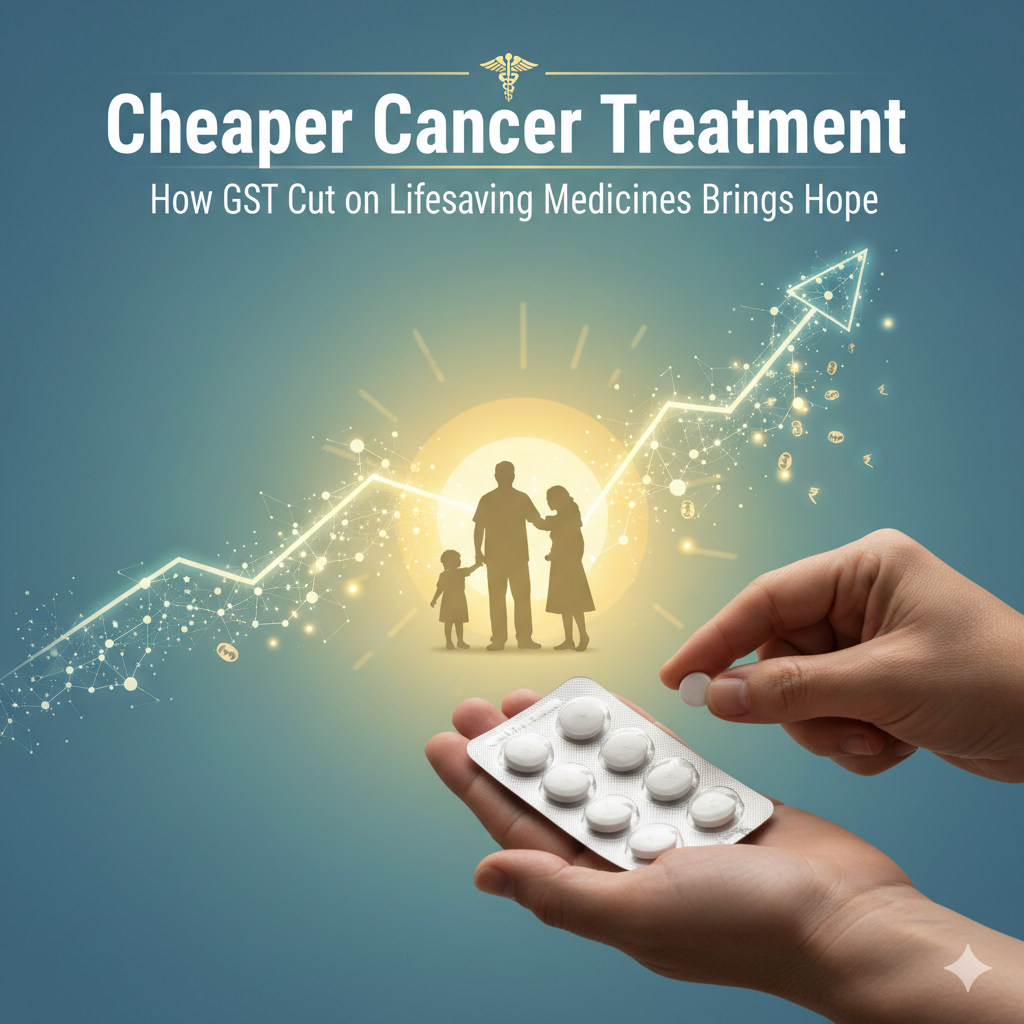How a Simple Tax Change Could Lighten the Burden on Cancer Patients

If you or someone you love is battling cancer, every rupee counts. Fortunately, a recent policy shift by the Indian government is bringing tangible relief: the Goods and Services Tax (GST) on many life-saving medicines has been slashed — in many cases, to zero. The result? Treatments that were once financially crippling may now become more accessible. Let’s break down what’s changed, what it means, and how far this move can go in easing suffering.
What Exactly Changed?
1. Full GST exemption on 36 life-saving drugs
On 22 September 2025, the government announced that 36 lifesaving medicines, including many used in cancer, rare genetic disorders, and chronic conditions, will now attract 0% GST. (India Today)
Some of these were earlier taxed at 5%, others at 12%. Now they’re fully exempt. (mint)
2. Most other medicines: tax cut from 12% to 5%
Medicines not in that 36-drug list will generally see their GST rate drop from 12% → 5%. (The Times of India)
This is a sweeping reform under the new GST 2.0 architecture. (Wikipedia)
3. Medical devices, diagnostics & related tools also benefit
It’s not just medicines. Many devices, diagnostic kits, reagents, and tools used in treatment will also see reduced tax rates. (mint)
Hospitals and suppliers have been ordered to revise MRPs accordingly. (The Times of India)
Why This Matters: The Real Impact on Patients
💸 Direct Cost Savings, Especially on High-Cost Therapies
For expensive cancer drugs, biologics, and gene therapies, removing 12% tax can save lakhs or significant portions of treatment cost over a long course. (India Today)
For example, in one public estimate, a cancer drug regimen earlier costing hundreds of thousands might see a reduction in drug component by nearly 5–12% purely via tax removal. (India Today)
✅ Better Access & Adherence
Lower costs mean fewer patients will have to skip doses or abandon essential treatment. This could improve outcomes and reduce complications.
Families already facing catastrophic health spending may breathe easier.
🏥 Benefit to Hospitals, Clinics & Procurement
Hospitals buying in bulk now pay lower taxes on their procurements (for affected drugs/devices). Over time, this could bring down institutional costs, making care more affordable.
Governments, charities, and insurance schemes may stretch their budgets further.
Things to Watch & Caveats
- MRP adjustments may take time
The retail price tags (MRPs) often include taxes. Changing those printed values and ensuring retailers pass on the benefits may lag in practice. - Old stock & inventory issues
Pharmacies holding stock purchased under old tax rates might resist re-pricing or delay adjustments. (The Times of India) - Industry behavior
Manufacturers or distributors might absorb part of the benefit or re-adjust other margins instead of fully passing gains to patients. - Availability still matters
Tax relief doesn’t instantly fix supply chain gaps, manufacturing shortages, or regulatory delays in getting the drugs to every region. - Remaining medicines remain taxed (at 5%)
Not all cancer medicines are in the 36-drug list. Many drugs, especially generics, will still attract GST at 5%. (mint)
What You Can Do (as a Patient, Advocate, Caregiver)
- Ask for revised bills
When buying drugs, ensure the pharmacy bills reflect the new tax rates. If not, question them or check with the National Consumer Helpline. (The Times of India) - Stay informed about which drugs are in the 36-drug list
The full list includes names like Onasemnogene abeparvovec, Daratumumab, Alectinib, Mepolizumab, etc. (mint) - Engage with patient support groups & media
Amplify awareness so that this policy fulfills its promise on the ground, and patients across India benefit, not just in metros. - Advocate further
Demand that governments extend exemptions, monitor compliance, and ensure pricing transparency for all life-saving therapies.
Final Thought: A Beacon of Hope — But Not a Cure-All
This GST reduction is a bold move toward health equity. It signals that the government recognizes the enormous financial strain patients endure. But policy is just a first step — implementation, transparency, and vigilant public participation will determine how many people truly benefit.
In the battle against cancer and other life-threatening illnesses, this change does not cure — but it may lift a heavy burden. Share widely, urge accountability, and let hope carry forward.
For more regular updates you can visit our social media accounts,
Instagram: Follow us
Facebook: Follow us
WhatsApp: Join us
Telegram: Join us


